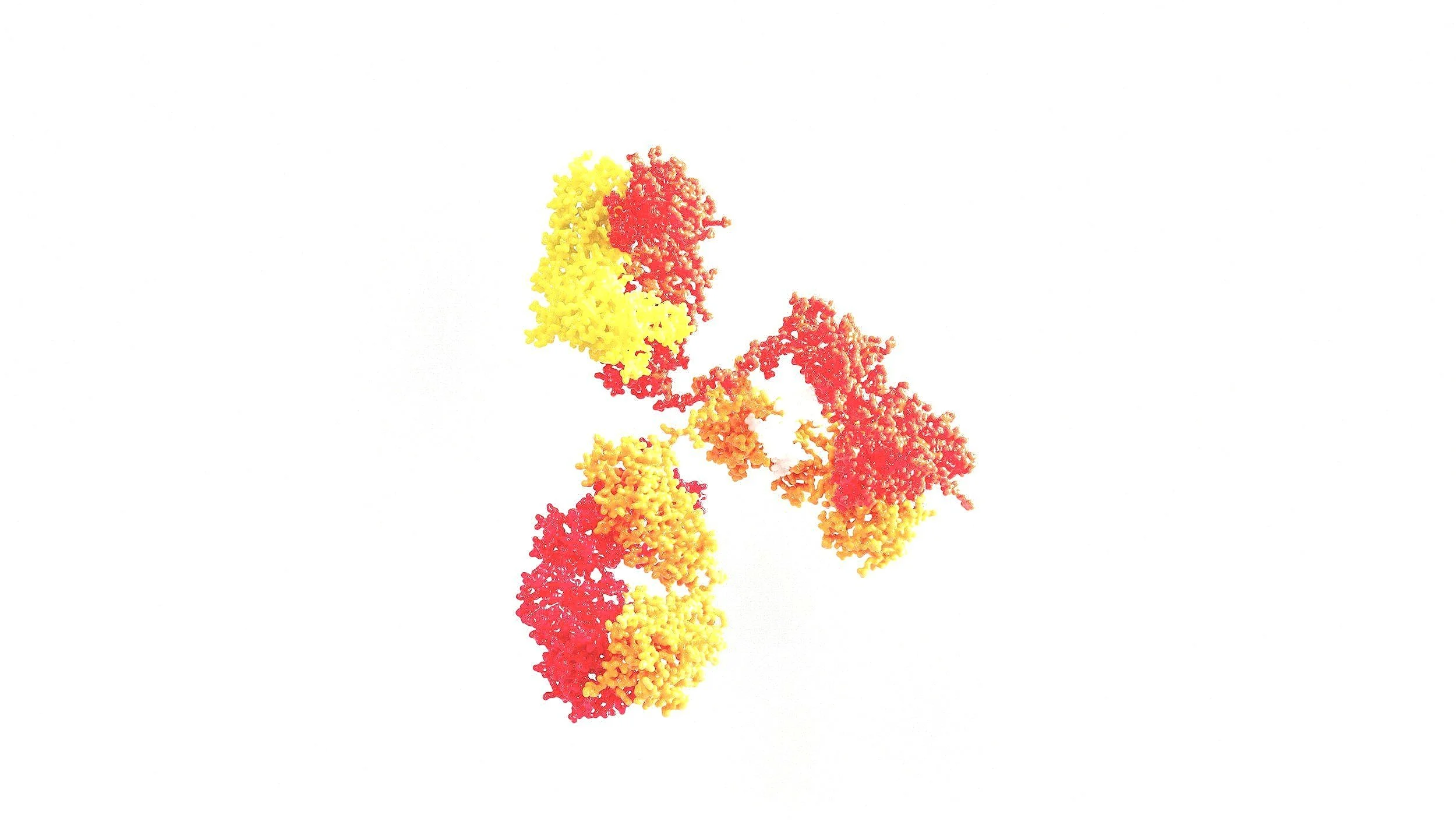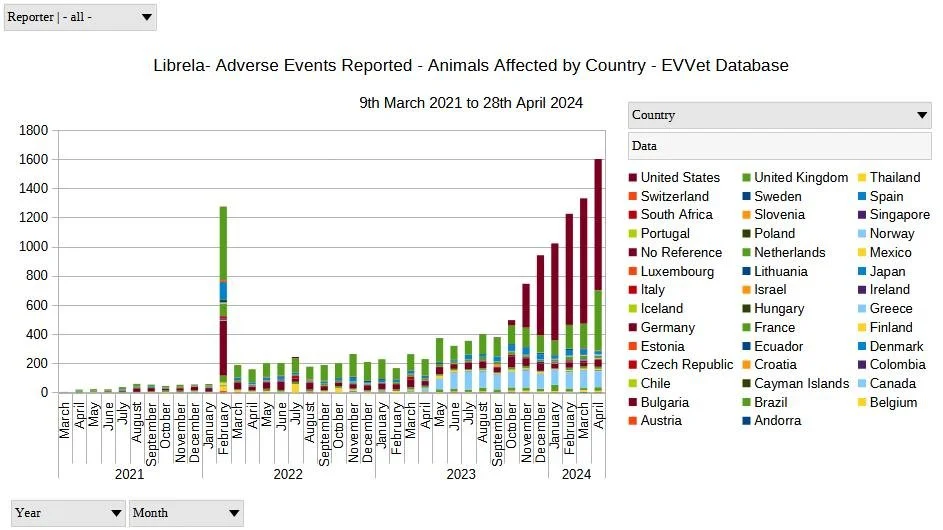Librela
-
Librela (Beransa) is a relatively new treatment for the management of osteoarthritic pain in dogs. It is composed of a genetically engineered protein called Bedinvetmab which is a monoclonal antibody specifically designed to bind to a protein in the body called Nerve Growth Factor (NGF) for the purpose of relieving joint pain in dogs. Zoetis’ description of Librela
-
NGF is a member of the neurotrophin family of growth factors. It is produced by various cell types, including immune cells, and acts on specific receptors known as TrkA receptors, which are found on the surface of neurons. When NGF binds to these receptors, it triggers a series of signaling pathways that promote neuronal growth, differentiation, and survival.
NGF is particularly important during development, where it helps guide the growth of nerve fibers and the formation of neural connections. It also plays a role in regulating the sensitivity of sensory neurons, influencing how we perceive sensations such as pain, temperature, and touch.
-
Monoclonal Antibodies (mAb) are are a type of synthetically produced antibody that are designed to target and bind to specific proteins, cells, or other substances in the body.
The mechanism of action in mABs such as Librela for dogs is to block or down-regulate specific proteins or receptors that are involved in cascades of inflammatory, regulatory, and homeostatic mechanisms. These receptors are nearly always found throughout a broad range of tissues in the body not ju.t arthritic joints.
If bedinvetmab binds to healthy proteins in the body, it often causes harm and upsets the homeostasis of the organism.
Source: Dr. Edward Bassingthwaighte
Librela is only indicated for use in dogs with Osteoarthritis.
Why Librela is causing problems
-
NGF has many important and complex roles in many body systems. NGF is involved in the growth, maintenance and survival of nerve cells and has a critical protective role in the development and survival of sympathetic, sensory and forebrain cholinergic neuron
-
Other systems in which NGF has a vital role include: heart/cardiovascular, immune, inflammation response/control, intestine, kidney, endocrine (pancreatic islet cells, adrenal gland, pituitary gland), energy allocation and metabolism
-
Once Librela has bound to NGF, it prevents it from attaching to its receptors on nerve cells and interrupts the transmission of pain signals. However, NGF is not just present in arthritic joints, but rather is produced by every peripheral tissue/organ that is innervated by sensory afferents and/or sympathetic efferents, as well as by central and peripheral nervous system and immune cells causing immune and nervous system dysfunction, among other problems.
-
When anti-NGF activity disrupts the body’s ability to fight against a wide range of microbial threats, this can lead to:
• increased susceptibility to infection
• chronic Inflammation
• allergic reactions
• autoimmune response
-
NGF is not only involved in pain signaling, but it’s very important for the growth, maintenance, and survival of nerve cells in the central and peripheral nervous system. Because endogenous NGF signaling subserves neuroprotective and repair functions, when the sympathetic nervous system is disrupted the resulting reduction in NGF may result in
• vomiting
• diarrhea
• low heart rate
• reduced appetite
• lethargy
• depression
• worsening heart failure in pets with cardiac disease
• low blood pressure
• low blood sugar
• cough
• collapse
• difficulty breathing
-
It's also worth noting that Librela only masks the perception of pain - it does not reduce inflammation or exert a positive effect on the degenerative changes present and does nothing to alter the underlying pathology present in various joint structures, including cartilage, synovial fluid, bones and associated muscles, tendons, ligaments and fibrous tissues. Source: Dr. Vince
-
It is estimated that up to 20% of all dogs may experience an adverse reaction from Librela.
Some adverse reactions are significant, including a chance of irreversible injury that could lead to death, or the need for euthanasia before the medicine has worn off.
The problem is that if your dog does experience an adverse reaction, once Librela is administered, it will continue to cause harm until the body slowly clears it from the system, which can take several weeks.
-
While the information provided by Zoetis does not include contraindications, many vets are of the opinion that Librela should not be prescribed for dogs with neurological conditions, IVDD and other spinal conditions, kidney disease, and dogs recovering from surgery. Source: Librela Experiences Facebook files
Additionally there is a PRECAUTION in the US prescribing information regarding dogs with cardio-vascular issues “NGF is expressed within the heart and vasculature, and the long-term effects of reduced NGF in dogs with cardiac disease are unknown.” Source: Zoetis
AVMA Veterinary Oath
I solemnly swear to use my scientific knowledge and skills for the benefit of society through the protection of animal health and welfare, the prevention and relief of animal suffering, the conservation of animal resources, the promotion of public health, and the advancement of medical knowledge. I will practice my profession conscientiously, with dignity, and in keeping with the principles of veterinary medical ethics. I accept as a lifelong obligation the continual improvement of my professional knowledge and competence.
In 1986, Italian neurobiologist Rita Levi-Montalcini and biochemist Stanley Cohen won the Nobel Prize in Physiology or Medicine for discovering nerve growth factor (NGF).
“ A body without nerve growth factor is a body without life.” Rita Levi-Montalcini




